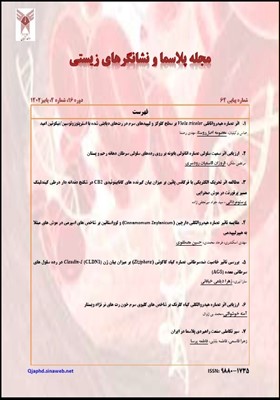اثر هم افزایی اکسی توسین با آگونیست گیرنده مو اپیوئیدی بر اخذ غذای مرکزی در جوجه های نوزاد
محورهای موضوعی : مجله پلاسما و نشانگرهای زیستی
فرامرز راجی
1
,
مرتضی زنده دل
2
*
![]() ,
بیتا وزیر
3
,
احمد اصغری
4
,
نگار پناهی
5
,
بیتا وزیر
3
,
احمد اصغری
4
,
نگار پناهی
5
1 - گروه علوم پایه، دانشکده دامپزشکی، واحد علوم و تحقیقات، دانشگاه آزاد اسلامی، تهران، ایران
2 - گروه علوم پایه، دانشکده دامپزشکی، دانشگاه تهران، تهران، ایران
3 - گروه علوم پایه، دانشکده دامپزشکی، واحد علوم و تحقیقات، دانشگاه آزاد اسلامی، تهران، ایران
4 - گروه علوم درمانگاهی، دانشکده دامپزشکی، واحد علوم و تحقیقات، دانشگاه آزاد اسلامی، تهران، ایران
5 - Islamic Azad University, Science and Research Branch
کلید واژه: اخذ غذا, اکسیتوسین, جوجههای تخمگذار, گیرندههای اپیوئیدی,
چکیده مقاله :
زمینه و هدف: سیستم اپیوئیدرژیک و گیرندههای مختلف آن نقش مهمی در کنترل مرکزی اخذ غذا در پرندگان ایفا میکنند. از سوی دیگر، اثر کاهشی اکسیتوسین نیز بر اخذ غذا پرندگان مشاهده شده است. مطالعه کنونی با هدف بررسی اثرات همافزایی اکسیتوسین با سیستم اپیوئیدرژیک بر رفتار تغذیهای در جوجههای تخمگذار صورت گرفته است.روش کار: این مطالعه در سه آزمایش انجام گرفت، به طوریکه هر آزمایش از یک گروه کنترل و سه گروه تیمار تشکیل شده بود. در تمامی گروهها، پرندگان تزریق داخل بطنی مغزی محلول رقیق کننده یا محلول دارویی را پس از 3 ساعت محرومیت غذایی دریافت کردند. در آزمایش اول: سرم فیزیولوژی، اکسیتوسین(16/0 نانومول )، DAMGO(آگونیست گیرندههای مو اپیوئیدی، 5/62 پیکومول) و اکسیتوسین به همراه DAMGO تزریق گشت. آزمایشهای بعدی مطابق با آزمایش اول انجام شدند، با این تفاوت که DPDPE (آگونیست گیرندههای دلتا اپیوئیدی، 20 نانومول) در آزمایش دوم و U-50488H(آگونیست گیرندههای کاپا اپیوئیدی، 10 نانومول) در آزمایش سوم، جایگزین DAMGO شده و به تنهایی و همراه با اکسیتوسین تزریق شدند. پس از تزریق، آب و غذا بدون محدودیت در دسترس پرندگان قرار گرفت و مصرف غذا (گرم) بر اساس درصد وزن بدن اندازه گیری شد.یافتهها: نتایج نشان داد که تزریق همزمان دوزهای تحت اثر اکسیتوسین و DAMGO منجر به کاهش معنیدار اخذ غذا شد (05/0 p<).نتیجهگیری: بر اساس یافتهها، به نظر میرسد احتمالا یک اثر همافزایی بین اکسیتوسین با آگونیست گیرنده مو اپیوئیدی در کنترل اخذ غذا در جوجههای تخمگذار وجود دارد.
Introduction & Objective: The opioidergic system and its different receptors play an important role in the central control of food intake in birds. On the other hand, the decreasing effect of oxytocin on food intake of birds has been observed. The present study was conducted to investigate the synergistic effects of oxytocin with opioid receptors on food intake in neonatal layer chickens.Materials and Methods: In this study, three experiments were designed, so that each experiment included one control group and three treatment groups. In all groups, birds received intracerebroventricular injection of diluent solution or drug solution after 3 hours of food deprivation. In the first experiment, normal saline, oxytocin(0.16 nmol), DAMGO(62.5 picomol) (agonist of mu-opioid receptors) and oxytocin plus DAMGO were injected. The other experiments were conducted as experiment 1, but instead of DAMGO, DPDPE (20 nmol)(agonist of delta opioid receptors) in the experiment 2 and U-50488H (10 nmol)(agonist of kappa opioid receptors) in experiment 3 were injected either alone or in combination with oxytocin. After the injection, water and food were freely available to the birds and then cumulative food intake (gr) was measured based on the percentage of the body weight.Results: The results of the present study showed that sub effective dose injection of oxytocin plus DAMGO significantly reduced food intake in layer chickens (P<0.05).Conclusion: According to the results of the present study, there is probably a synergistic effect between oxytocin with mu-opioid receptors agonist on food intake control of neonatal layer chicks.
1.Simpson K. A. Martin N. M. & Bloom S. R. . Hypothalamic regulation of food intake and clinical therapeutic applications. Arquivos brasileiros de endocrinologia e metabologia 2009 : 53(2), 120–128.
45. Olszewski, P. K. Complexity of neural mechanisms underlying overconsumption of sugar in scheduled feeding: involvement of opioids, orexin, oxytocin and NPY. Peptides 2009: 30(2), 226–233.
_||_
